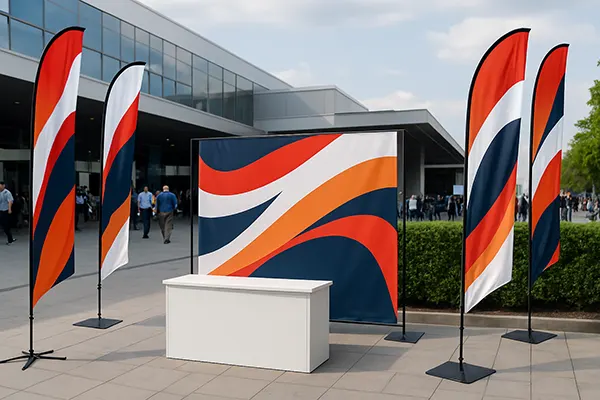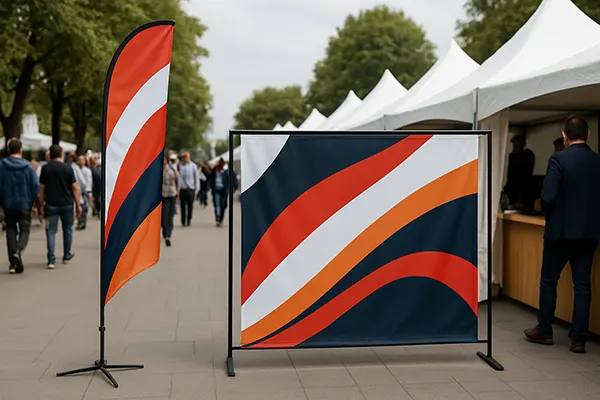
Creating a powerful visual identity at public events is essential for any brand seeking to enhance recognition and engagement. One of the most effective and budget-conscious methods involves the strategic use of branded flags and banners. These visual tools not only attract attention but also communicate a brand’s message instantly, reinforcing its presence in a crowded market. As of February 2025, brands continue to prioritise physical visibility at events despite the digitalisation of many marketing processes.
The Power of Visual Impact in Brand Zones
Flags and banners serve as a silent yet powerful communicator of brand values. When used strategically at exhibitions, trade shows, festivals, or corporate gatherings, they transform regular event spaces into immersive brand environments. Eye-catching designs, vibrant colours, and strategic placement guide visitors’ attention directly to the brand, creating lasting visual impressions.
Modern printing technologies in 2025 allow for high-resolution, weather-resistant, and eco-friendly materials, ensuring that banners remain durable while supporting sustainable business practices. Brands increasingly opt for recyclable textiles and water-based inks, blending responsibility with aesthetics. This reflects a global trend of integrating environmental awareness into promotional strategies.
Furthermore, the psychology of colour and typography plays a significant role. The right combination can influence how attendees perceive and remember a brand. Using established brand colours on flags and banners reinforces familiarity, while concise, bold slogans improve recall and engagement, especially when visitors are overwhelmed with stimuli at large events.
Case Studies of Effective Flagship Branding
One noteworthy example from 2024 was a multinational tech brand at the Web Summit in Lisbon. Their use of 6-metre-high vertical flags at every entrance ensured instant visibility, while internally placed banners framed every networking zone, reinforcing their leadership image. Attendee surveys showed a 28% higher brand recall rate compared to competitors without physical branding elements.
Similarly, a Danish fashion brand at Copenhagen Fashion Week integrated minimalist banners and logo flags into its booth design. The subtle branding approach aligned with its visual identity and attracted a high number of organic social media shares from attendees impressed by the cohesive look. The event led to a measurable 17% increase in online store traffic within 72 hours.
These examples highlight that successful brand zones are not just about size or volume of materials, but about coherence, placement, and visual storytelling. Even smaller-scale events benefit when brands approach their space with thoughtful flag and banner integration.
Strategic Design Principles for Event Branding
Design is at the heart of every successful branding initiative. For flags and banners to truly resonate, they must go beyond logo placement. In 2025, best practices emphasise clarity, simplicity, and alignment with broader marketing goals. Designers are encouraged to limit clutter, focusing instead on legible fonts and focal visuals that connect emotionally with the audience.
Contrast is key in outdoor settings where lighting and movement may vary. Light backgrounds with dark text (or vice versa) ensure readability from afar. Animations or QR codes can also be integrated if they serve a purpose, such as guiding visitors to a campaign page or app download, but they should not overwhelm the primary message.
Adaptability is another critical factor. Brands should prepare banner and flag designs that can be reused across multiple event formats — from conferences to music festivals — with only minor adjustments. This not only saves budget but also reinforces consistency across touchpoints. Templates and modular designs are particularly helpful for scalability.
Design Tools and Production Trends in 2025
Many companies now rely on AI-assisted design tools that streamline the creation of banners and flags. These tools offer pre-tested layouts based on marketing performance metrics, helping brands avoid design pitfalls. However, human input remains essential in aligning visuals with brand voice and campaign objectives.
Production-wise, 3D fabric printing and sustainable dye-sublimation are gaining popularity. These methods produce rich, textured visuals without compromising on environmental standards. Suppliers are also offering on-demand printing services, enabling quick turnarounds for last-minute events while reducing storage needs.
Overall, the fusion of design intelligence with eco-responsible production is reshaping how branded materials are conceived and executed. Brands that embrace this evolution stand out not only visually but also ethically, an increasingly important factor for modern consumers.

Integrating Banners and Flags into the Event Journey
Flags and banners should be positioned with intent throughout the attendee journey. From the initial welcome zone to keynote areas and breakout sessions, these elements act as navigational aids while subtly reinforcing branding. The layout should mirror the customer journey, ensuring seamless brand exposure without seeming forced.
Entrance areas benefit from tall feather flags and overhead banners to create anticipation. Within event halls, retractable banners work well in guiding flow towards key attractions such as product showcases or consultation corners. At exit points, closing messages on banners can drive follow-up actions, such as visiting a website or scanning a QR code for exclusive content.
Interactivity also plays a role. Photo walls with branded backgrounds or gamified banner spaces enhance engagement. Encouraging visitors to take photos and share them with event-specific hashtags further amplifies visibility beyond the physical event, merging offline presence with online reach.
Measuring the Success of Visual Branding at Events
To evaluate the effectiveness of banner and flag integration, brands are increasingly using digital tools to track performance. QR scans, social media mentions, and heatmaps from foot traffic data help marketers understand which placements yielded the highest engagement.
Pre- and post-event surveys also remain valuable. By comparing brand awareness and message retention before and after an event, companies can fine-tune their visual strategy for future appearances. Metrics such as “brand recall within 24 hours” are commonly used benchmarks.
Finally, ROI should be assessed not only in terms of direct sales or leads but also in visibility, reach, and brand sentiment. These qualitative insights are critical for understanding long-term brand positioning and should be part of every flagship marketing report.
